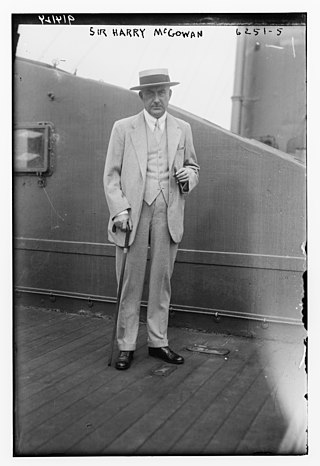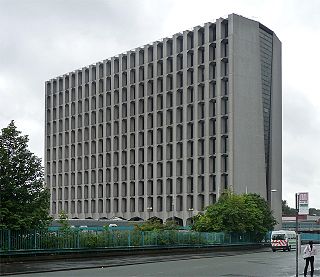Related Research Articles

Imperial Chemical Industries (ICI) was a British chemical company. It was, for much of its history, the largest manufacturer in Britain. It was formed by the merger of four leading British chemical companies in 1926. Its headquarters were at Millbank in London. ICI was a constituent of the FT 30 and later the FTSE 100 indices.

The chemical industry comprises the companies that develop and produce industrial, specialty and other chemicals. Central to the modern world economy, it converts raw materials into industrial and consumer products. The plastics industry contains some overlap, as some chemical companies produce plastics as well as chemicals.

I. G. Farbenindustrie AG, commonly known as IG Farben, was a German chemical and pharmaceutical conglomerate. Formed in 1925 from a merger of six chemical companies—BASF, Bayer, Hoechst, Agfa, Chemische Fabrik Griesheim-Elektron, and Chemische Fabrik vorm. Weiler Ter Meer—it was seized by the Allies after World War II and divided back into its constituent companies.

BASF SE, an acronym for its original name Badische Anilin- und Sodafabrik, is a European multinational company and the largest chemical producer in the world. Its headquarters are located in Ludwigshafen, Germany.

Hoechst AG was a German chemicals then life-sciences company that became Aventis Deutschland after its merger with France's Rhône-Poulenc S.A. in 1999. With the new company's 2004 merger with Sanofi-Synthélabo, it became a subsidiary of the resulting Sanofi-Aventis pharmaceuticals group.
Allied Corp. was a major American company with operations in the chemical, aerospace, automotive, oil and gas industries. It was initially formed in 1920 as the Allied Chemical and Dye Corporation as an amalgamation of five chemical companies. In 1958, it was renamed Allied Chemical Corporation when it diversified into oil and gas exploration. Allied Chemical then became Allied Corporation in 1981. In 1985, Allied merged with the Signal Companies to become AlliedSignal. AlliedSignal would eventually acquire Honeywell in 1999 and then adopt its name.
The American IG Chemical Corporation, or American IG for short, was an American holding company incorporated under the Delaware General Corporation Law in April 1929 and headquartered in New York City. It had stakes in General Aniline Works (GAW), Agfa-Ansco Corporation, and Winthrop Chemical Company, among others, and was engaged in manufacture and sale of pharmaceuticals, photographic products, light weight metals, synthetic gasoline, synthetic rubber, dyes, fertilizers, and insecticides. The Moody's industrial manual listed an affiliation between IG Farben and American IG at the time of founding. First, Hermann Schmitz, who was the second after Carl Bosch in IG Farben's hierarchy, and then his brother, Dietrich A. Schmitz, served as American IG's presidents. It was re-incorporated as General Aniline & Film (GAF) Corp. in 1939 after a merger with General Aniline Works.

Friedrich Carl Duisberg was a German chemist and industrialist.
United Alkali Company Limited was a British chemical company formed in 1890, employing the Leblanc process to produce soda ash for the glass, textile, soap, and paper industries. It became one of the top four British chemical companies merged in 1926 with Brunner Mond, Nobel Explosives and British Dyestuffs Corporation to form Imperial Chemical Industries.
Nobel Enterprises is a chemicals business that used to be based at Ardeer, in the Ayrshire town of Stevenston, in Scotland. Specialising in nitrogen-based propellants and explosives and nitrocellulose-based products such as varnishes and inks. It was formerly ICI Nobel, a division of the chemicals group ICI, but was then sold to Inabata, a Japanese trading firm. The business was sold on to Chemring Group in 2005 and is now a Scottish Company, part of Chemring Group.
Tata Chemicals Europe is a UK-based chemicals company that is a subsidiary of Tata Chemicals Limited, itself a part of the India-based Tata Group. Its principal products are soda ash, sodium bicarbonate, calcium chloride and associated alkaline chemicals.

Harry Duncan McGowan, 1st Baron McGowan KBE LLD DCL, was a prominent British industrialist who served as Chairman of Imperial Chemical Industries for 20 years.
The Clayton Aniline Company Ltd. was a British manufacturer of dyestuffs, founded in 1876 by Charles Dreyfus in Clayton, Manchester.

Hickson & Welch was a British chemicals company based in Castleford.

Hexagon Tower is a specialist science and technology facility located in Blackley, North Manchester, United Kingdom.
Dr Cecil John Turrell Cronshaw FRSE DSc was a British industrial chemist, Manager of the Manchester Ship Canal and Director of the chemical giant, ICI. He was involved in the evolution of modern industrial dyes.
Levinstein Ltd was an important Manchester based British dye-making company founded by Ivan Levinstein (1845-1916). In 1918 the firm became part of British Dyestuffs Corporation which in turn formed part of Imperial Chemical Industries in 1926. The firm had operations in Salford, Hulton House in Blackley, and during World War I a sequestered German-owned plant in Ellesmere Port. The firm made the successful Blackley blue or Coomassie brilliant blue, a Manchester Brown, a Manchester Yellow dye and during WWI chemicals for military purposes.

Ivan Levinstein (1845-1916) was a German-born British chemist who pioneered the manufacture of synthetic dyes and helped develop the British chemical industry in the late nineteenth century. He was born in Charlottenburg, Germany, the son of a Berlin Calico manufacturer, studied chemistry at the Gewerbeinstitut, which later became the Technical University of Berlin, before joining the family business. He obtained his first patent in Germany in 1863 for improvements in manufacturing coal tar dyes.
The chemical industry of India is a major industry in the Indian economy and as of 2022, contributes 7% of the country's Gross Domestic Product (GDP). India is the world's sixth largest producer of chemicals and the third largest in Asia, as of 2022. The value of the Indian chemical industry was estimated at $100 billion dollars in 2019. The chemical industry of India generates employment for five million people. The Indian chemical industry produces 80,000 different chemical products. India was also the third largest producer of plastic in 2019. As of September 2019, the alkali chemical industry produced 71% of all chemicals produced in India. India's chemical industry accounts about 14% of production in Indian industries.

Marl Chemical Park is an industrial park in Marl, North Rhine-Westphalia, Germany. It is the third largest industrial cluster in Germany and among the largest chemical production facilities in Europe. The site occupies over 6 square kilometers, hosts 100 chemical plants, employs 10,000 people, and produces 4 million metric tons of chemicals annually. 18 companies are based in the Park, including primary tenant Evonik Industries AG, which also owns and operates the infrastructure through its subsidiary Infracor GmbH.
References
- ↑ Colorants History [Usurped!]
- 1 2 3 4 "British Dyes Ltd./British Dyestuffs Corporation Ltd. - ICI Dyestuffs Division and predecessor companies archive - Archives Hub". archiveshub.jisc.ac.uk. Retrieved 14 June 2021.
- 1 2 "British Dyestuffs Corporation and ICI". www.colorantshistory.org. Archived from the original on 4 July 2007. Retrieved 14 June 2021.
- 1 2 "British Dyestuffs Corporation". www.gracesguide.co.uk. Retrieved 6 January 2023.
- ↑ "British Dyestuffs Corporation Limited | Science Museum Group Collection". collection.sciencemuseumgroup.org.uk. Retrieved 14 June 2021.